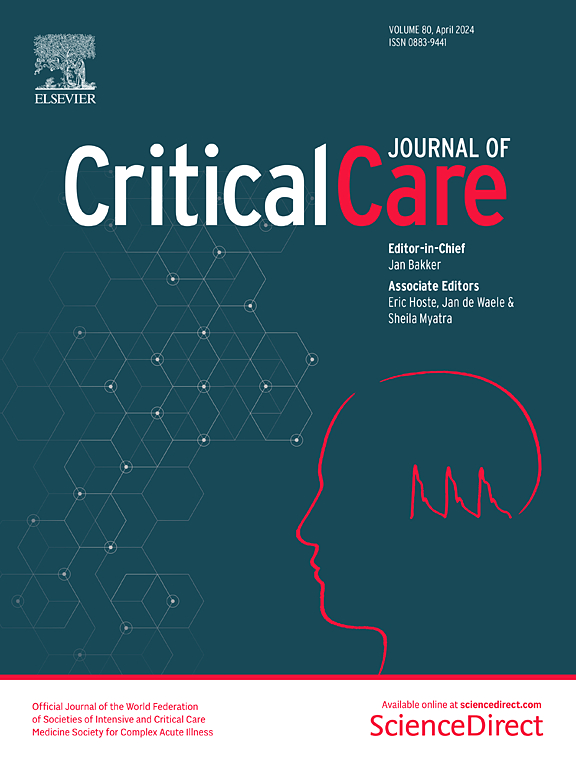稳定性脓毒症伴积液的转化猪模型的体积动力学
IF 8.8
1区 医学
Q1 CRITICAL CARE MEDICINE
引用次数: 0
摘要
脓毒症发生期间和之后的流体动力学是复杂的,但更好的知识可以指导液体复苏和液体清除。我们的目的是比较脓毒症前后的流体动力学在临床相关的单细菌猪模型。12头平均体重为56公斤的母猪被麻醉,机械通气,并进行有创监测。脓毒症通过静脉输注铜绿假单胞菌诱导。动物在急性化粪池期根据协议算法复苏。在细菌输注前(基线)和24小时后(脓毒症晚期)研究体积动力学,两者都包括在20分钟内输注1500 mL 0.9%生理盐水,反复测量血红蛋白和白蛋白并定量尿液。基线时的动力学分析显示,中央液体室(等离子体)的体积瞬间膨胀,间隙快速交换,而更多的液体逐渐积聚在远处的“第三流体空间”,周转非常缓慢。脓毒症晚期出现低白蛋白血症和轻度低血容量血症。与基线相比,流体动力学显示等离子体膨胀改善,快速交换间隙的扩张比慢交换间隙的扩张更多。在脓毒症晚期,描述血液回流的速率常数k21增加,血红蛋白-白蛋白稀释差异表明,液体输注时发生了间质白蛋白招募。该模型预测高心脏指数和败血症引起的体重增加与更大的快速交换室扩张有关。脓毒症后,液体积聚在慢交换室,进一步的液体给药优先分布到快交换室,淋巴流动加速,血浆扩张改善,间质白蛋白募集。本文章由计算机程序翻译,如有差异,请以英文原文为准。
Volume kinetics in a translational porcine model of stabilized sepsis with fluid accumulation
Fluid dynamics during and after a septic event is complex, but better knowledge could guide both fluid resuscitation and fluid removal. We aimed to compare fluid dynamics before and after sepsis in a clinically relevant mono-bacterial porcine model. Twelve sows with a mean body weight of 56 kg were anesthetized, mechanically ventilated, and invasively monitored. Sepsis was induced with an intravenous infusion of P. aeruginosa. Animals were resuscitated during the acute septic phase according to a protocolized algorithm. Volume kinetics was studied before the bacterial infusion (baseline) and 24 h later (late sepsis), and both consisted of an infusion of 1,500 mL of 0.9% saline over 20 min with repeated hemoglobin and albumin measurements and urine quantification. The kinetic analysis at baseline showed transient volume expansion of the central fluid compartment (the plasma) and a fast-exchange interstitial space, while gradually more fluid accumulated in the remote “third fluid space” with very slow turnover. In the late sepsis phase, hypoalbuminemia and slight hypovolemia was observed. As compared with baseline, fluid kinetics showed improved plasma expansion, and more expansion of the fast-exchange interstitial space rather than the slow-exchange space. The rate constant k21 describing return flow to the circulation was increased during the late sepsis phase, and hemoglobin-albumin dilution difference suggested that interstitial albumin recruitment occurred with the fluid infusion. The model predicted that high cardiac index and sepsis-induced weight gain were associated with greater fast-exchange compartment expansion. After sepsis, fluid was accumulated in the slow-exchange compartment, and further fluid administration distributed preferentially to the fast-exchange compartment with acceleration of lymph flow, improved plasma expansion, and recruitment of interstitial albumin.
求助全文
通过发布文献求助,成功后即可免费获取论文全文。
去求助
来源期刊

Critical Care
医学-危重病医学
CiteScore
20.60
自引率
3.30%
发文量
348
审稿时长
1.5 months
期刊介绍:
Critical Care is an esteemed international medical journal that undergoes a rigorous peer-review process to maintain its high quality standards. Its primary objective is to enhance the healthcare services offered to critically ill patients. To achieve this, the journal focuses on gathering, exchanging, disseminating, and endorsing evidence-based information that is highly relevant to intensivists. By doing so, Critical Care seeks to provide a thorough and inclusive examination of the intensive care field.
 求助内容:
求助内容: 应助结果提醒方式:
应助结果提醒方式:


